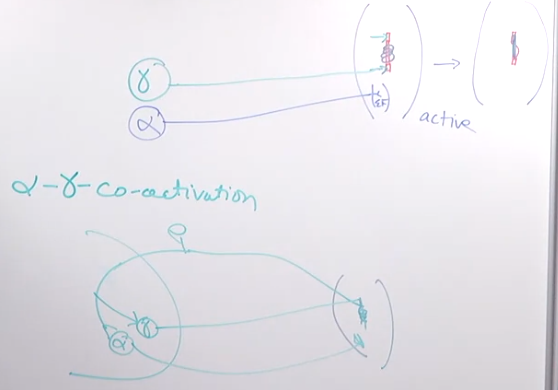 Introduction:
Introduction:
- The lecture is about understanding reflexes, specifically the stretch reflex (monosynaptic reflex).
- The stretch reflex is the reflex tested by physicians when tapping the knee.
- It is considered one of the most complicated circuits to understand.
Muscle Structure and Function:
- Muscles contain large muscle fibers that produce force when contracted, shortening the muscle.
- Interspersed among these large fibers are small packages called muscle spindles.
- Muscle spindles contain 5-10 very thin muscle fibers called intrafusal fibers.
- The large force-generating fibers are called extrafusal fibers.
- Intrafusal fibers do not produce force but serve a sensory role.
The Stretch Reflex Mechanism:
- When the muscle is stretched, the intrafusal fibers within the muscle spindles are stretched.
- Sensory neurons wrap around these intrafusal fibers and are activated when they are stretched.
- These sensory neurons are called primary afferents, with cell bodies in the dorsal root ganglion.
- The primary afferent enters the spinal cord and synapses directly onto a motor neuron (one synapse in the CNS).
- This motor neuron then innervates and contracts the extrafusal fibers in the same muscle.
- So when the muscle is stretched, it contracts back via this reflex arc (stretch → contract).
- This corrective feedback mechanism is a protective response.
Key Points:
- Called the monosynaptic reflex due to the single synapse in the CNS.
- Also called the stretch reflex since muscle stretch initiates the reflex.
- It is a very fast reflex, occurring within milliseconds.
- Muscle spindles are distributed throughout the muscle, so any stretch can activate the reflex.
- Activated by unexpected loads, weights, or forces applied to the muscle.
Muscle Spindles and Alpha-Gamma Coactivation
Key Points:

- Muscle Spindles: These are specialized sensory organs located within muscles that contain intrafusal muscle fibers.
- Intrafusal Muscle Fibers: Unlike regular muscle fibers (extrafusal fibers) that contract to generate force, intrafusal muscle fibers primarily sense changes in muscle length.
- Gamma Motor Neurons: These motor neurons innervate the polar ends of intrafusal muscle fibers. When stimulated, they cause the intrafusal muscle fibers to contract.
- Alpha Motor Neurons: These motor neurons innervate extrafusal muscle fibers and are responsible for muscle contraction.
The Stretch Reflex:
- Muscle Shortening: When a muscle actively contracts, it shortens. This can cause slack in the intrafusal muscle fibers, making them insensitive to stretch.
- Alpha-Gamma Coactivation: To maintain sensitivity to stretch, the nervous system activates gamma motor neurons along with alpha motor neurons during muscle contraction.
- Intrafusal Fiber Contraction: Gamma motor neuron stimulation causes the intrafusal muscle fibers to contract, taking up the slack and keeping them taut.
- Stretch Detection: Even during muscle contraction, the sensory part of the intrafusal muscle fiber remains sensitive to further stretch.
Maintaining Muscle Tone:
- Alpha-gamma coactivation ensures continuous sensory input from muscle spindles, which is crucial for maintaining muscle tone.
- Muscle tone refers to the slight, constant state of muscle contraction that helps maintain posture and stability.
The Gamma Loop and Cerebellar Control of Muscle Tone
 Key Points:
Key Points:
- Gamma Loop: This indirect pathway involves the cerebellum stimulating gamma motor neurons, which contract intrafusal muscle fibers, maintaining their sensitivity to stretch and influencing alpha motor neurons to regulate muscle tone.
- Cerebellum and Muscle Tone: The cerebellum plays a crucial role in maintaining muscle tone by influencing the gamma loop. Damage to the cerebellum can lead to hypotonia (reduced muscle tone).
- Gamma Loop and Movement Control: The gamma loop also helps us make precise movements and maintain balance by adjusting our sensitivity to muscle stretch. This is especially important for complex or challenging movements where the risk of falling is high.
Examples:
- Tightrope Walking: The tightrope walker requires heightened sensitivity to muscle stretch to maintain balance and prevent falls. The gamma loop likely plays a role in achieving this.
- Walking on Ice: When walking on slippery surfaces, the nervous system unconsciously activates gamma motor neurons to increase sensitivity to stretch and prevent us from slipping.
Conclusion:
Spinal reflexes, including the gamma loop, are essential for maintaining muscle tone, balance, and coordinated movements.